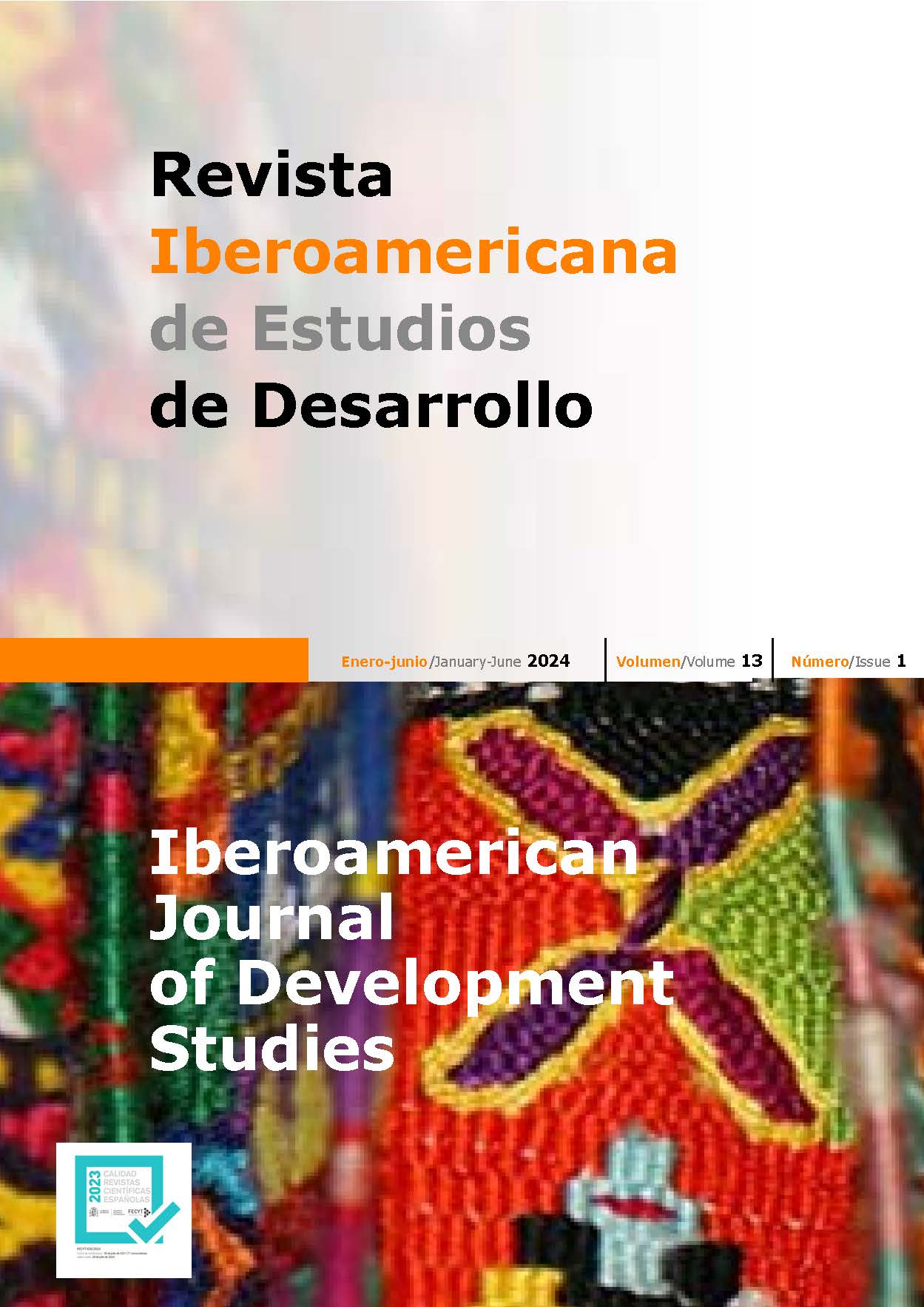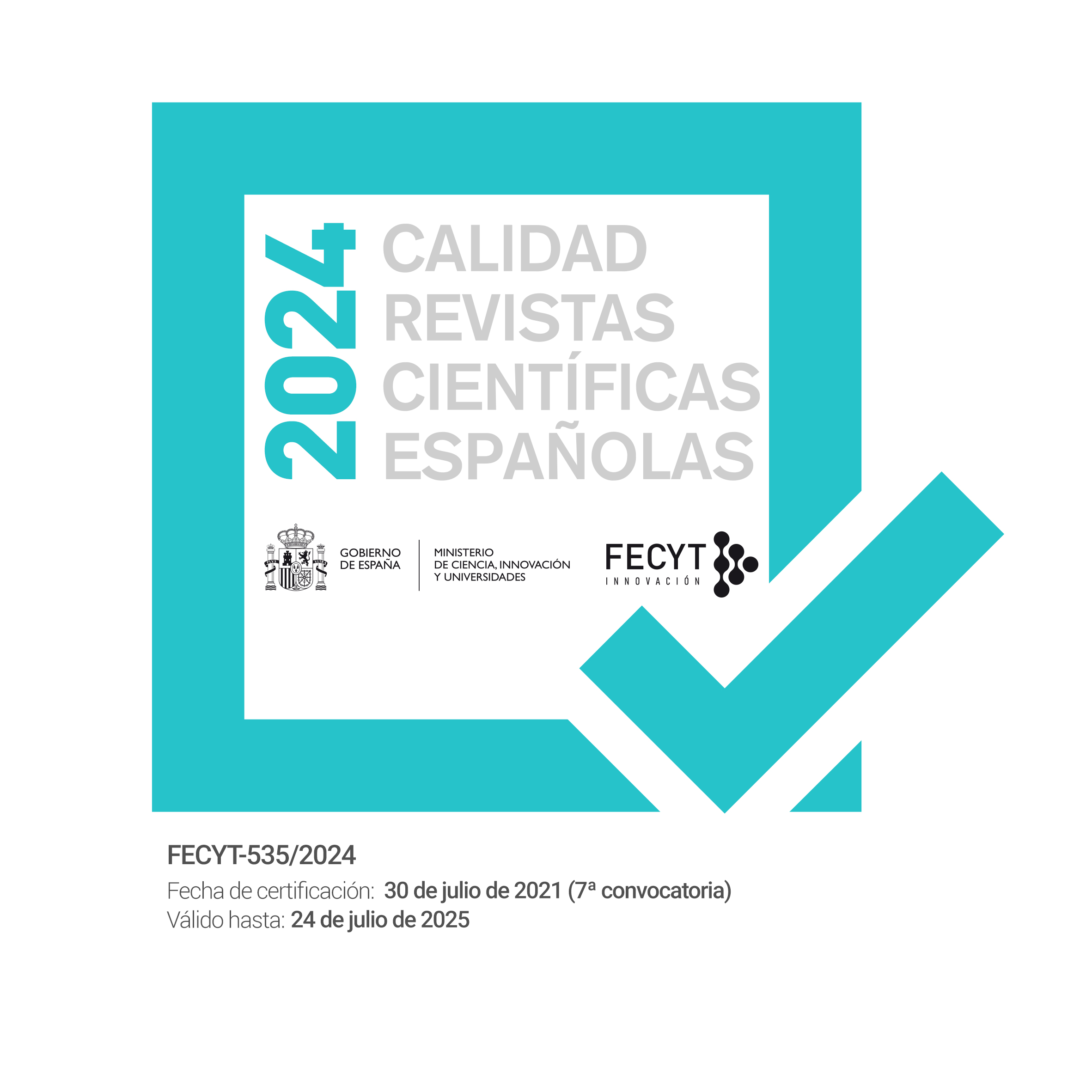Más profesionales en ciencia, ingeniería y tecnología, más movilidad intergeneracional de ingresos en Latinoamérica
DOI:
https://doi.org/10.26754/ojs_ried/ijds.785Palabras clave:
movilidad intergeneracional de ingresos, clase creativa, carreras de CIT, desajuste de habilidadesResumen
La movilidad intergeneracional de ingresos (MII) es la capacidad para cambiar de clase social, independientemente de la clase social de origen. Si bien en Latinoamérica la MII es especialmente baja, una nueva clase creativa ha logrado llegar a los deciles más altos en la región sin necesariamente pertenecer a la clase dominante. Dado que los creativos en ciencia, ingeniería y tecnología (CIT) están especialmente bien remunerados y hay un exceso de demanda desde el mercado laboral, planteamos como hipótesis que el aumento de profesionales en CIT aumentaría la MII en Latinoamérica. La metodología aplicada tiene dos pasos: primero, clasificamos 72 países del mundo en tres grupos según su MII —7 son latinoamericanos—; segundo, estimamos un probit ordenado para saber si las publicaciones en CIT (como un proxy de los profesionales de estas carreras) incide en la probabilidad de que los países latinoamericanos considerados pasen de un grupo a otro. Los resultados confirman la hipótesis.
Descargas
Referencias
AEDO C, WALKER C (2012). Skills for the 21st Century in Latin America and the Caribbean. The World Bank, Washington, DC. DOI: https://doi.org/10.1596/978-0-8213-8971-3
ALDENDERFER MS, BLASHFIELD RK (1984). Cluster Analysis. Sage, Newbury Park (California). DOI: https://doi.org/10.4135/9781412983648
ALEJO OJ, BERGOLO SOSA ML, CARBAJAL ESPINAL F (2014). Las transferencias públicas y su impacto distributivo: la experiencia de los países del Cono Sur en la década de 2000. El trimestre económico 81(231):163-198. DOI: https://doi.org/10.20430/ete.v81i321.111
ALVAREDO F, GASPARINI L (2015). Recent trends in inequality and poverty in developing countries. Handbook of Income Distribution 2(1):697-805. DOI: https://doi.org/10.1016/B978-0-444-59428-0.00010-2
ANTONELLI C, FASSIO C (2016). Academic knowledge and economic growth: are scientific fields all alike? Socio-Economic Review 14(3):537-565. DOI: https://doi.org/10.1093/ser/mwv025
ARAYA F (2019). Evidencia sobre la movilidad intergeneracional de ingresos laborales para un país en desarrollo: el caso de Uruguay. El Trimestre Económico 86:265. https://doi.org/10.20430/ete.v86i342.722, acceso 15 de enero de 2022. DOI: https://doi.org/10.20430/ete.v86i342.722
ARREDONDO FG, VÁZQUEZ JC, VELÁZQUEZ LM (2019). CIT y brecha de género en Latinoamérica. Revista de El Colegio de San Luis 9(18):137-158. DOI: https://doi.org/10.21696/rcsl9182019947
BANCO MUNDIAL (2022a). Global Database on Intergenerational Mobility. https://datacatalog.worldbank.org/search/dataset/0050771/global-database-on-intergenerational-mobilit, acceso 15 de enero de 2022.
BANCO MUNDIAL (2022b). Base de datos. https://datos.bancomundial.org/, acceso 15 de enero de 2022.
BASSI M, BUSSO M, URZUA S, VARGAS J (2012). Desconectados: habilidades, educación y empleo en América Latina. Inter-American Development Bank, Washington, DC.
BAUMAN Z (2001). Modernidade líquida. Editora Schwarcz-Companhia das Letras.
BEHRMAN JR, GAVIRIA A, SZÉKELY M, BIRDSALL N, GALIANI S (2001). Intergenerational mobility in Latin America. Economia 2(1):1-44. DOI: https://doi.org/10.1353/eco.2001.0010
BJÖRKLUND A, JÄNTTI M (2009). Intergenerational income mobility and the role of family background. Oxford Handbook of Economic Inequality 491(1):521.
BLANDEN J (2013). Cross‐country rankings in intergenerational mobility: a comparison of approaches from economics and sociology. Journal of Economic Surveys 27(1):38-73. DOI: https://doi.org/10.1111/j.1467-6419.2011.00690.x
BONILLA-MEJÍA L, BONILLA-MEJÍA L (2011). Movilidad intergeneracional en educación en las ciudades y regiones de Colombia. En: Movilidad intergeneracional en educación en las ciudades y regiones de Colombia, cap. 8, pp. 287-309. DOI: https://doi.org/10.32468/dtseru.130
CHEN X, SOLDNER M (2013). CIT attrition: College students’ path into and out of CIT fields. National Center for Education Statistics. https://files.eric.ed.gov/fulltext/ED544470.pdf, acceso 14 de enero de 2019.
CHETTY R, HENDREN N, KLINE P, SAEZ E (2014). Where is the land of opportunity? The geography of intergenerational mobility in the United States. The Quarterly Journal of Economics 129(4):1553-1623. DOI: https://doi.org/10.1093/qje/qju022
COHEN WM (2010). Fifty years of empirical studies of innovative activity and performance. Handbook of the Economics of Innovation 1(1):129-213. DOI: https://doi.org/10.1016/S0169-7218(10)01004-X
CORAK M (2013). Income Inequality, Equality of Opportunity, and Intergenerational Mobility. Journal of Economic Perspectives 27(3):79-102. https://doi.org/10.1257/jep.27.3.79, acceso 24 de enero de 2022. DOI: https://doi.org/10.1257/jep.27.3.79
DALLE P, BONIOLO P, NAVARRO CENDEJAS J (2019). Logro educativo y movilidad intergeneracional de clase en Argentina y México. Viejos y nuevos clivajes de la desigualdad educativa en Iberoamérica, febrero. https://www.jstor.org/stable/j.ctvt6rmc8.7, acceso 3 de enero de 2022. DOI: https://doi.org/10.2307/j.ctvt6rmc8.7
DENNER J, RIVERA G (2011). Latinos’ educational pathways: Research and program perspectives. Latina and Latino Children’s Mental Health 1(1):149-167.
DOERINGER PB, PIORE MJ (1985). Internal Labor Markets and Manpower Analysis. Me Sharpe.
EDWARDS AW, CAVALLI-SFORZA LL (1965). A Method for Cluster Analysis. Biometrics:362-375. DOI: https://doi.org/10.2307/2528096
FISZBEIN A, COSENTINO C, CUMSILLE B (2016). The skills development challenge in Latin America: diagnosing the problems and identifying public policy solutions. Inter-American Dialogue and Mathematica Policy Research, Washington, DC.
FLORIDA R (2014). The creative class and economic development. Economic Development Quarterly 28(3):196-205. DOI: https://doi.org/10.1177/0891242414541693
FREHILL LM, DI FABIO NM, HILL ST (2008). Confronting the new American dilemma: underrepresented minorities in engineering: a data-based look at diversity. National Action Council for Minorities in Engineering, White Plains (Nueva York).
FUNK C, PARKER K (2018). Diversity in the CIT workforce varies widely across jobs. Pew Research Center 9.
GALIANI S, CRUCES G, ACOSTA P, GASPARINI LC (2017). Educational upgrading and returns to skills in Latin America: evidence from a supply-demand framework (No. w24015). National Bureau of Economic Research. DOI: https://doi.org/10.3386/w24015
GÁNDARA P, CONTRERAS F (2020). The Latino Education Crisis. Harvard University Press.
GONZÁLEZ C, PEÑA N (2019). Demanda de trabajo en América Latina: ¿qué podemos aprender de los portales de vacantes online? Banco Interamericano de Desarrollo.
GONZÁLEZ-VELOSA C, RUCCI G, SARZOSA M, URZÚA S (2015). Returns to Higher Education in Chile and Colombia (No. IDB-WP-587). IDB Working Paper Series. DOI: https://doi.org/10.18235/0011686
GOOD C, ARONSON J, HARDER JA (2008). Problems in the pipeline: stereotype threat and women’s achievement in high-level math courses. Journal of Applied Developmental Psychology 29(1):17-28. DOI: https://doi.org/10.1016/j.appdev.2007.10.004
HARVEY D (1998). La condición de la posmodernidad. Amorrortu Editores.
HERRERO-OLARTE S (2022). Salario mínimo, pobreza y clase media. El caso ecuatoriano. Regional and Sectoral Economic Studies 22(1):95-106.
HERTZ T, JAYASUNDERA T, PIRAINO P, SELCUK S, SMITH N, VERASHCHAGINA A (2007). The inheritance of educational inequality: international comparisons and fifty-year trends. The B.E. Journal of Economic Analysis and Policy 7(2):4-30. DOI: https://doi.org/10.2202/1935-1682.1775
HOM E (2014). What is CIT Education?
HUBER E, STEPHENS JD (2012). Democracy and the left: social policy and inequality in Latin America. University of Chicago Press, Chicago. DOI: https://doi.org/10.7208/chicago/9780226356556.001.0001
JANVRY AD, SADOULET E (2000). Growth, poverty, and inequality in Latin America: a causal analysis, 1970-94. Review of Income and Wealth 46(3):267-287. DOI: https://doi.org/10.1111/j.1475-4991.2000.tb00843.x
JENSEN P, ROUQUIER J-B, CROISSANT Y (2009). Testing bibliometric indicators by their prediction of scientists promotions. Scientometrics 78(3):467-479. https://doi.org/10.1007/s11192-007-2014-3, acceso 21 de noviembre de 2021. DOI: https://doi.org/10.1007/s11192-007-2014-3
JIMÉNEZ M (2011). Un análisis empírico de las no linealidades en la movilidad intergeneracional del ingreso. El caso de Argentina. Working papers del Cedlas.
JIMÉNEZ M (2017). Movilidad intergeneracional y gasto público en Argentina. Revista de Análisis Económico 32:65-108. http://www.scielo.cl/scielo.php?script=sci_arttext&pid=S0718-88702017000200065&nrm=iso, acceso 15 de noviembre de 2021. DOI: https://doi.org/10.4067/S0718-88702017000200065
KLEIBRINK J (2016). Inept or badly matched? Effects of educational mismatch in the labor market. Labour 30(1):88-108. DOI: https://doi.org/10.1111/labr.12065
KUHN A (2019). The subversive nature of inequality: subjective inequality perceptions and attitudes to social inequality. European Journal of Political Economy 59(1):331-344. DOI: https://doi.org/10.1016/j.ejpoleco.2019.04.004
LAVADO P, MARTÍNEZ J, YAMADA G (2015). Calidad de la educación superior y desigualdad en los retornos en el Perú, 2012. Ministerio de Educación de Perú. DOI: https://doi.org/10.21678/978-9972-57-356-9-9
LEE H, LEE JW (2020). Patterns and determinants of intergenerational educational mobility: evidence across countries. Pacific Economic Review. https://doi.org/10.1111/1468-0106.12342, acceso 15 de diciembre de 2021. DOI: https://doi.org/10.1111/1468-0106.12342
LEVITSKY S, ROBERTS KM (eds.) (2011). The Resurgence of the Latin American Left. JHU Press. DOI: https://doi.org/10.1353/book.1866
LUSTIG N (ed.) (2018). Commitment to equity Handbook: Estimating the Impact of Fiscal Policy on Inequality and Poverty. Brookings Institution Press.
LUSTIG N, LOPEZ-CALVA LF, ORTIZ-JUAREZ E (2013). Declining inequality in Latin America in the 2000s: the cases of Argentina, Brazil, and Mexico. World Development 44:129-141. DOI: https://doi.org/10.1016/j.worlddev.2012.09.013
MANPOWER GROUP. Talent Shortage Survey. 2015 Talent Shortage Survey Results. https://www.manpowergroup.co.uk/wp-content/uploads/2015/06/2015_TalentShortageSurvey_FINAL_lores.pdf, acceso 24 de diciembre de 2021.
MEIN E (2019). Key sociocultural influences shaping Latinx students’ pathways to engineering/CS: an ethnographic lens. In: ASEE Annual Conference Proceedings, enero.
MIJS JJ (2021). The paradox of inequality: income inequality and belief in meritocracy go hand in hand. Socio-Economic Review 19(1):7-35. DOI: https://doi.org/10.1093/ser/mwy051
NARAYAN A, VAN DER WEIDE R, COJOCARU A, LAKNER C, REDAELLI S, MAHLER DG, THEWISSEN S (2018). Fair progress?: economic mobility across generations around the world. World Bank Publications. DOI: https://doi.org/10.1596/978-1-4648-1210-1
NATIONAL SCIENCE FOUNDATION. (2016). Science and Engineering Indicators. http://www.nsf.gov/statistics/2016/nsb20161/#/, acceso 21 de diciembre de 2021.
NEIDHÖFER G (2019). Intergenerational mobility and the rise and fall of inequality: lessons from Latin America. The Journal of Economic Inequality 17(4):499-520. DOI: https://doi.org/10.1007/s10888-019-09415-9
NELSON KL, NELSON LKK, MCDANIEL JR, TACKETT S (2019). Majoring in CIT: how the factors of fear of failure, impostor phenomenon, and self-efficacy impact decision-making. National Social Science Journal 52(1):76.
OECD (2022). Base de datos, acceso 15 de enero de 2022.
OECD, CAF (2014). Latin American Economic Outlook 2015. https://doi.org/10.1787/leo-2015-en, acceso 10 de noviembre de 2021. DOI: https://doi.org/10.1787/leo-2015-en
PAGEGROUP (2022). Estudio de Perspectivas LATAM 2022. https://www.michaelpage.com.mx/estudios-y-tendencias/perspectivas-2022, acceso 10 de noviembre de 2021.
PINTO T, TEIXEIRA AA (2020). The impact of research output on economic growth by fields of science: a dynamic panel data analysis 1980-2016. Scientometrics 123(2):945-978. DOI: https://doi.org/10.1007/s11192-020-03419-3
ROUSSEEUW PJ (1987). Silhouettes: a graphical aid to the interpretation and validation of cluster analysis. Journal of Computational and Applied Mathematics 20:53-65. DOI: https://doi.org/10.1016/0377-0427(87)90125-7
SCHULTZ TW (1961). Investment in human capital. The American Economic Review 51(1):1-17.
SU R, ROUNDS J, ARMSTRONG PI (2009). Men and things, women and people: a meta-analysis of sex differences in interests. Psychological Bulletin 135(6):859-884. https://doi.org/10.1037/a0017364, acceso 4 de enero de 2021. DOI: https://doi.org/10.1037/a0017364
TEECE DJ (2007). Explicating dynamic capabilities: the nature and microfoundations of (sustainable) enterprise performance. Strategic Management Journal 28(13):1319-1350. DOI: https://doi.org/10.1002/smj.640
VÁZQUEZ ALONSO Á, MANASSERO MAS MA (2015). La elección de estudios superiores científico-técnicos: análisis de algunos factores determinantes en seis países. Revista Eureka sobre Enseñanza y Divulgación de las CIT 12(2):264. DOI: https://doi.org/10.25267/Rev_Eureka_ensen_divulg_cienc.2015.v12.i2.03
VERYZER JR RW (1998). Discontinuous innovation and the new product development process. Journal of Product Innovation Management: An International Publication of the Product Development & Management Association 15(4):304-321. DOI: https://doi.org/10.1016/S0737-6782(97)00105-7
VILLARÁN F, GOLUP R (2010). Emergencia de la Ciencia, la Tecnología y la Innovación (CTI) en el Perú. Organización de Estados Iberoamericanos 1(1):8-48.
WERNER L, DENNER J (2009). Pair programming in middle school: what does it look like? Journal of Research on Technology in Education 42(1):29-49. DOI: https://doi.org/10.1080/15391523.2009.10782540
WOOLDRIDGE JM (2008). Introductory Econometrics: A Modern Approach, 4th edition. South-Western.
WORLD BANK (2018). Global Database on Intergenerational Mobility. https://www.worldbank.org/en/topic/poverty/brief/what-is-the-global-database-on-intergenerational-mobility-gdim, acceso 10 de enero de 2021.
XUE Y, LARSON RC (2015). CIT crisis or CIT surplus? Yes and yes. Monthly Labor Review. DOI: https://doi.org/10.21916/mlr.2015.14
ZILBERMAN A, ICE L (2021). Why computer occupations are behind strong CIT employment growth in the 2019-29 decade. Computer 4(5164):11-15.
Descargas
Publicado
Número
Sección
Licencia
Derechos de autor 2024 Susana Herrero-Olarte

Esta obra está bajo una licencia internacional Creative Commons Atribución-NoComercial-SinDerivadas 4.0.






